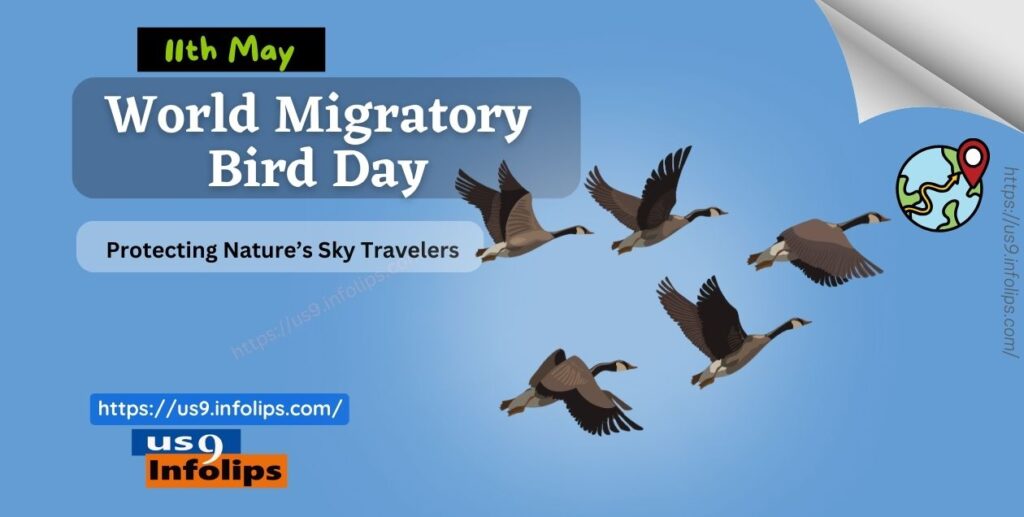World Migratory Bird Day: Protecting Nature’s Sky Travelers – Best Info
World Migratory Bird Day: Celebrating the Wonders of Winged Wanderers”
Migratory birds are nature’s globetrotters, crossing continents and oceans in their incredible journeys. World Migratory Bird Day (WMBD) celebrates these feathered travelers and raises awareness about their conservation. But what makes this day so special? Let’s explore its history, significance, and some fascinating (and controversial) facts!
Table of Contents
Key Aspects of World Migratory Bird Day
- Why It Started – Migratory birds face threats like habitat loss, climate change, and hunting. WMBD was created to highlight these challenges and inspire global action.
- Who Takes Initiative? – The day is coordinated by two UN treaties: the Convention on Migratory Species (CMS) and the African-Eurasian Migratory Waterbird Agreement (AEWA).
- The History – First launched in 2006, it began as an awareness campaign to protect migratory birds and their habitats.
- When Is It Celebrated? – Originally observed on the second weekend of May, but since 2018, it’s also marked on the second Saturday of October to cover migrations in different hemispheres.
- The Theme Changes Yearly – Each year focuses on a new conservation issue, like light pollution (2022) or water conservation (2023).
- How People Celebrate – Birdwatching events, educational programs, art competitions, and habitat clean-ups happen worldwide.
- Global Participation – Over 100 countries join in, with events organized by schools, NGOs, and governments.
- The Role of Technology – Scientists use satellite tracking and apps like eBird to study migration patterns.
- Why Birds Matter – They pollinate plants, control pests, and indicate ecosystem health.
- A Call to Action – WMBD encourages individuals to reduce plastic use, protect wetlands, and keep skies dark at night for safe migration.
Objectives of World Migratory Bird Day
- Raise awareness about migratory birds.
- Promote global conservation efforts.
- Highlight threats like habitat destruction.
- Encourage international cooperation.
- Educate communities on bird protection.
- Reduce human-made hazards (e.g., pollution, illegal hunting).
- Support research on migration patterns.
- Inspire youth involvement in conservation.
- Celebrate the cultural significance of birds.
Facts About WMBD
- The first WMBD was celebrated in Kenya in 2006.
- Over 40% of migratory birds are in decline.
- The Arctic Tern holds the record for the longest migration—up to 71,000 km yearly!
- Some birds, like the Bar-tailed Godwit, fly non-stop for 11 days!
- Light pollution disorients millions of birds annually.
- WMBD was initially called “International Migratory Bird Day” in the Americas.
- Birds like the Common Cuckoo are cultural symbols in many countries.
- Bird-friendly coffee farms help protect migratory routes.
- Social media trends like #WorldMigratoryBirdDay boost engagement.
9 Unknown & Interesting Facts
- Some birds sleep while flying by shutting down one brain hemisphere.
- The Amur Falcon travels from Siberia to Africa—22,000 km yearly!
- Birds use Earth’s magnetic field to navigate.
- The Himalayas act as a migration superhighway for many species.
- Ancient Egyptians worshipped migratory birds like the Ibis.
- Wind turbines kill thousands of birds annually, raising conservation debates.
- The Red Knot changes its digestive organs before migration to store energy.
- Some birds mimic human sounds during migration to communicate.
- Climate change is shifting migration timings, affecting ecosystems.
Controversies Around World Migratory Bird Day
- Hunting Conflicts – Some countries allow bird hunting despite conservation efforts.
- Wind Farms vs. Birds – Renewable energy projects sometimes harm migratory routes.
- Urbanization – Cities disrupt flight paths, leading to bird collisions.
- Pesticides – Chemicals like DDT (banned but still used in some places) weaken birds.
- Political Barriers – Not all nations enforce migratory bird protection laws.
- Light Pollution Debate – Some cities resist dimming lights for bird safety.
- Invasive Species – Non-native predators threaten nesting sites.
- Tourism Impact – Excessive birdwatching can disturb habitats.
- Climate Denial – Some groups downplay how global warming affects migration.
Conclusion :
World Migratory Bird Day is more than a celebration—it’s a global call to protect these incredible travelers. From ancient navigation skills to modern-day threats, their journeys remind us of nature’s delicate balance. By taking small steps—like reducing plastic, keeping lights off, or supporting conservation—we can ensure skies remain filled with wings for generations to come.
FAQs
Q1: When is World Migratory Bird Day?
A: Twice a year—second Saturday in May and October.
Q2: Who organizes WMBD?
A: CMS and AEWA, supported by NGOs and governments.
Q3: Why is it celebrated twice?
A: To cover migration cycles in both hemispheres.
Q4: How can I participate?
A: Join birdwatching events, reduce plastic, or educate others.
Q5: What is the biggest threat to migratory birds?
A: Habitat loss and climate change.
Q6: Do all birds migrate?
A: No, only some species undertake long journeys.
Q7: How do birds navigate?
A: Using stars, Earth’s magnetism, and landmarks.
Q8: Can I create a bird-friendly garden?
A: Yes! Plant native trees and provide clean water.
Q9: What’s the rarest migratory bird?
A: The Spoon-billed Sandpiper, with only few hundred left.
Disclaimer : This article is for informational purposes only. Conservation efforts may vary by region. For official guidelines, refer to CMS and AEWA websites.
Would you like any refinements or additional details? 😊
w us for more captivating articles and stay connected to explore the world. Let’s embrace the power of communication and understanding.

Related topics:
1. Perfect World Travel Guide
2. 9 Most Popular EV Cars in the USA
3. 9 Best Things About Apple TV 4K – Third Generation
4. Think before You Renew Amazon Prime
5. Jimmy Carter: A Great Legacy
6. Memorial Day: Honoring the Sacrifice, Celebrating Freedom
School Site :
For English grammar and lot more : Smart School Infolips
Marathi Poems: Marathi Rang
Technology : Tech Site











